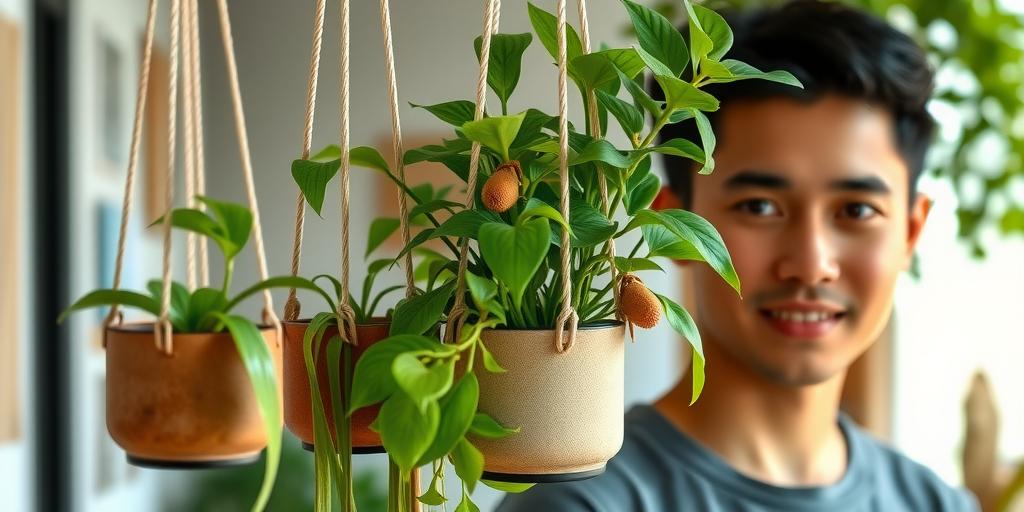
Sustainable Hanging Planters for Low Light Plants: Eco-Friendly Indoor Greenery
Discover the best sustainable hanging planters for low light plants! Explore eco-friendly materials, stylish designs, and expert tips to elevate your indoor garden. Perfect for urban dwellers and plant lovers.
Introduction
Did you know that indoor plants can improve air quality by up to 60%? But what if your space lacks natural sunlight? Low light plants like pothos, snake plants, and ZZ plants thrive in dim conditions, making them perfect for apartments and offices. Pair them with sustainable hanging planters, and you’ve got a stylish, eco-conscious indoor oasis! In this guide, we’ll explore the best materials, designs, and care tips to help you create a green sanctuary—without harming the planet.
Why Choose Sustainable Hanging Planters?
Benefits of Sustainable Materials
Sustainable hanging planters aren’t just good for your plants—they’re great for the planet too. Materials like biodegradable fibers, recycled plastics, and natural elements (think bamboo or cork) break down more easily than traditional plastics, reducing landfill waste. Plus, they often have a lower carbon footprint since they require less energy to produce. If you’re looking to minimize your environmental impact, choosing planters made from eco-friendly materials is a simple yet effective step.
Space-Saving and Air Circulation
Hanging planters are a game-changer for small spaces. Whether you live in a tiny apartment or just want to maximize your greenery without cluttering surfaces, suspending plants from the ceiling or walls keeps floors and shelves free. Another perk? Better air circulation. When plants are elevated, air flows more freely around their leaves, reducing the risk of mold or stagnant moisture—a common issue with potted plants sitting on surfaces.
Aesthetic Appeal
Eco-friendly doesn’t mean sacrificing style. In fact, sustainable hanging planters often bring a unique, artisanal touch to modern interiors. Whether it’s handwoven macramé, sleek bamboo, or upcycled ceramics, these planters add texture and warmth to any space. They blend seamlessly with minimalist, bohemian, or rustic décor, proving that sustainability can be just as chic as conventional options.
Best Materials for Eco-Friendly Hanging Planters
Recycled Macramé
Handmade macramé planters are a favorite for good reason. They’re crafted from natural or recycled cotton fibers, making them biodegradable and durable. The intricate knots add a boho-chic vibe, and since they’re breathable, they help prevent overwatering—ideal for plants that dislike soggy roots.
Bamboo
Bamboo is one of the most sustainable materials out there—it grows incredibly fast, requires minimal water, and is naturally pest-resistant. As a hanging planter material, it’s lightweight yet sturdy, making it perfect for both indoor and outdoor use. Plus, its natural grain adds an organic, earthy feel to any room.
Cork
Cork is harvested from the bark of cork oak trees without harming them, making it a renewable resource. It’s naturally moisture-resistant, so it won’t warp or rot when exposed to humidity. Its insulating properties also help regulate soil temperature, keeping roots happy. Cork planters have a soft, textured look that works well in modern and rustic spaces alike.
Upcycled Ceramics & Glass
Old jars, bottles, or broken ceramics can be transformed into stunning hanging planters. Upcycling these materials keeps them out of landfills while adding a touch of elegance. Glass terrariums or ceramic pots with drainage holes can be suspended with ropes or metal holders for a creative, eco-conscious display.
Coconut Coir
Made from the husks of coconuts, coir is a byproduct of the coconut industry, so it’s incredibly sustainable. It’s breathable and retains moisture well, making it ideal for plants that need consistent humidity. Coir-lined hanging baskets are especially great for ferns, orchids, and other tropical plants.
Top Low-Light Plants for Hanging Planters
Pothos (Epipremnum aureum)
Pothos is practically indestructible—it thrives in low light, grows quickly, and helps purify the air. Its trailing vines look stunning cascading from a hanging planter, and it’s forgiving if you forget to water it occasionally.
Spider Plant (Chlorophytum comosum)
Spider plants are adaptable and thrive in indirect light. They’re also pet-friendly (non-toxic to cats and dogs) and produce adorable baby “spiderettes” that dangle from the mother plant, adding visual interest.
ZZ Plant (Zamioculcas zamiifolia)
If you’re notorious for neglecting plants, the ZZ plant is your best bet. It survives in near-darkness and only needs watering every few weeks. Its glossy, dark green leaves add a sleek, modern touch to any space.
Philodendron Heartleaf
This trailing plant is perfect for hanging displays thanks to its long, heart-shaped leaves. It does well in low to moderate light and grows quickly, making it a great choice for filling empty corners.
Peperomia
Compact and colorful, peperomias come in a variety of leaf shapes and hues. They thrive in indirect light and don’t require frequent watering, making them a low-maintenance option for hanging planters.
How to Care for Hanging Plants in Low Light
Watering Tips
Low-light plants generally need less water because they grow more slowly. Overwatering is a common issue—always check the soil moisture before watering. If the top inch feels dry, it’s time to water. Ensure your planter has drainage holes to prevent root rot.
Best Fertilizers
Since low-light plants grow slower, they don’t need heavy feeding. A diluted, balanced liquid fertilizer every 4-6 weeks during the growing season (spring and summer) is usually sufficient. Organic options like worm castings or seaweed extract are great sustainable choices.
Pruning and Training Vines
To keep trailing plants looking full, trim leggy vines occasionally. Pinching back new growth encourages bushier foliage. Gently guide vines around hooks or frames to create a lush, cascading effect.
Signs Your Plant Needs More (or Less) Light
If leaves are pale, leggy, or smaller than usual, your plant might need more light. Move it closer to a window (but avoid direct sunlight). Yellowing leaves or slow growth could mean it’s getting too much light—adjust its position accordingly.
Styling Tips for Sustainable Hanging Planters
Layering at Different Heights
Hang planters at varying levels to create depth and visual interest. Mix short and long vines for a dynamic, jungle-like effect. Use ceiling hooks, wall brackets, or even tension rods to achieve this look.
Matching Materials to Décor
-
Boho: Macramé, woven fibers, and terracotta.
-
Minimalist: Sleek bamboo or geometric ceramic planters.
-
Rustic: Cork, upcycled wood, or metal with a patina.
Secure Installation
Choose sturdy hooks or ceiling mounts that can support the weight of your planter (especially when wet). For heavier materials like ceramic or glass, ensure the hardware is rated for the load.
Grouping Plants
Cluster multiple hanging planters together for a mini indoor jungle. Combine different textures (e.g., a trailing pothos with a spiky spider plant) for contrast.
Where to Buy Sustainable Hanging Planters
Ethical Brands
Look for companies that prioritize sustainability, like those using recycled materials or fair-trade practices. Brands like The Sill, Ecoforms, or local artisans often offer eco-friendly options.
DIY Upcycled Options
Get creative with household items—turn old mason jars, tin cans, or even wine bottles into hanging planters. Add rope or wire for suspension, and drill drainage holes if needed.
Local Artisans vs. Online Marketplaces
-
Local Artisans: Supports small businesses, often handmade and unique. You can inspect quality in person.
-
Online Marketplaces: Wider variety, but shipping may increase carbon footprint. Check reviews to ensure ethical practices.
Whether you buy or DIY, sustainable hanging planters are a beautiful way to bring nature indoors while staying eco-conscious.
Conclusion
Sustainable hanging planters are more than just a trend—they’re a smart, stylish way to bring greenery into low-light spaces while reducing environmental impact. Whether you opt for bamboo, recycled macramé, or upcycled ceramics, there’s an eco-friendly planter to match your style. Ready to transform your space? Start with a pothos or spider plant in a sustainable hanger, and watch your indoor garden thrive!
